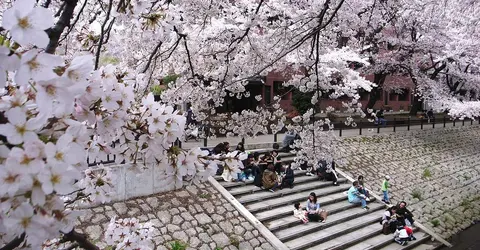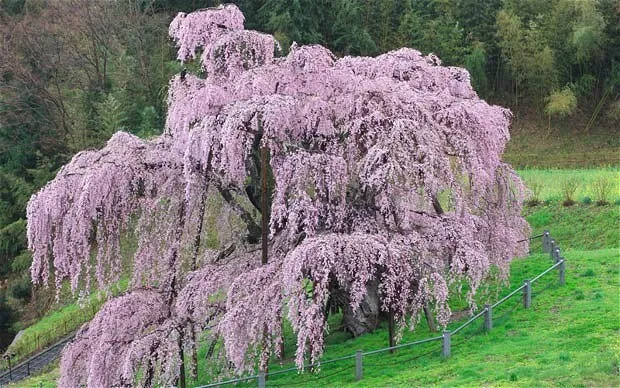Good news has a way of finding us when we need it the most. It often arrives quietly, in moments that could easily be overlooked—a stranger’s kindness, an unexpected recovery, a small but meaningful triumph over adversity. This spring, one such moment unfolded in a small Japanese community that had long cherished a very special friend: a cherry tree that had stood proudly for a century.
For years, this tree had been more than just a piece of nature. It was a part of the community’s identity—an emblem of the passing seasons, a backdrop for countless family memories, and an irreplaceable marker of local history. But when a violent storm tore through the region several years ago, the beloved sakura (cherry blossom) tree suffered significant damage. Branches were ripped away, its trunk split in places, and arborists declared that its chances of survival were slim.
So when the tree bloomed again this spring—soft pink petals bursting from branches once considered beyond repair—the entire community gathered, stunned and joyful. What they witnessed was more than a seasonal blossom. It was a miracle of resilience, a testament to nature’s quiet power, and a reminder that life often finds a way to rise again… even when everyone believes the story has ended.
This is the tale of the 100-year-old cherry tree that refused to give up—and how its unexpected revival became a symbol of hope not only for one Japanese neighborhood but for people everywhere seeking reassurance that renewal is always possible.
Table of contents
A Tree Older Than Memory
In rural Japan, ancient trees are treated with reverence. They are storytellers, elders, companions of generations. This particular cherry tree—planted sometime during the Taishō era (1912–1926)—was already mature when the grandparents of today’s residents were children. For decades, families picnicked beneath its shade, students gathered for graduation photos under its blossoms, and seasonal festivals were held in its honor.
Residents referred to the tree affectionately, calling it “Oba-sakura”—Grandmother Sakura.
Grandmother Sakura stood near a small shrine and was considered its guardian spirit. No spring felt complete without its heart-stirring bloom: thousands of petals appearing as if summoned by memory itself, layering the earth like pink snowfall.
But as the decades passed, storms grew harsher. Climate shifts brought unpredictable weather, and one particularly fierce storm five years ago caused damage that experts feared was irreversible. Its massive trunk cracked. Several supporting limbs were shattered. Local officials fenced the area off to prevent accidents, and for weeks, villagers visited silently, paying respects to a tree many believed was nearing its final chapter.
Even nature lovers prepared themselves emotionally for the loss. One elderly resident said, “I thought I would watch her fall before I fell.”
When Hope Appeared to Fade
After the storm, arborists and conservation specialists examined the tree in detail. Their assessment wasn’t optimistic. They recommended minimal pruning and supportive measures, not with the expectation of revival but with the intention of easing the tree’s decline.
As the following spring arrived, the blossoms were few—fragile, sparse, and disproportionately small compared to the tree’s former display. A year later, the flowers were fewer still. By the third spring, there were nearly none.
The community mourned quietly. Losing the sakura felt like losing a part of their shared history, something steady and familiar in a world that was rapidly changing.
Children left messages near the tree, drawings of pink blossoms with smiling faces. Elders offered silent prayers at the shrine beside it. People spoke of the tree not just as damaged, but as tired—having given all it had for more than a hundred years.
Yet, even in its weakened state, nature was still working.
Within the rough, weathered bark, tiny cells continued their quiet labor. Deep underground, roots still drank from the earth. And though no one could see it, something inside the tree was preparing for one more chance.
A Spring No One Expected
This year, as winter melted into warmer days, residents noticed something unusual—buds. More than in previous years. More than anyone dared to hope for.

At first people whispered, cautious not to jinx the moment. A local shopkeeper said she paused every morning on her way to open her store just to count the buds. A group of schoolchildren made a game of it, recording their daily “bud count” in notebooks decorated with hand-drawn sakura petals.
And then, one early morning in April, it happened.
Pink.
Soft, vibrant pink.
Not one blossom, not a few scattered petals—but dozens, then hundreds, then an explosion of flowers covering the branches that had once seemed lifeless.
News spread instantly. Neighbors knocked on each other’s doors. Families hurried to the shrine. Elderly residents walked slowly but determinedly to see the miracle with their own eyes.
One woman, who had visited the tree every spring for the past 63 years, cried the moment she saw it.
“It felt,” she said, “as if she had returned to us.”
The Community Celebration
Within days, local leaders organized a small celebration. It wasn’t a large festival—nothing loud or commercial—but a heartfelt gathering where residents shared tea, took photos, and recalled memories linked to the cherry tree.
Children performed a simple dance they called “Sakura’s Heartbeat.” Elders told stories about the tree as if reminiscing about an old friend’s remarkable recovery. People who had moved away returned to witness the bloom, saying it felt like coming home.
Visitors described the atmosphere as peaceful, emotional, and profoundly uplifting.
The village mayor thanked the tree during his brief speech, saying:
“You remind us that life continues even after hardship. You teach us patience. You show us that growth may look quiet, but it is never impossible.”
Local media covered the story. Photos circulated on social networks, where viewers from across Japan and even overseas expressed amazement and joy at the tree’s revival. Many commented that hearing such a story brought them comfort during a difficult year.
It wasn’t just a tree blooming—it was hope blooming.
Why Experts Believe the Tree Survived
Arborists who visited the site were surprised but not entirely mystified. They explained that older trees often possess remarkable resilience, especially those with deep, well-established roots.
Several factors likely contributed to the cherry tree’s survival:
1. Deep Root System
A century-old tree often develops roots that spread wide and deep, tapping into stable water sources. Even when branches fail, the root structure may remain strong.
2. Slow, Internal Healing
Trees have natural abilities to compartmentalize damage, forming protective barriers around injured tissue. Even if externally damaged, internal pathways can slowly repair themselves over years.
3. Community Care
Residents regularly checked the tree, removed debris, and ensured that the soil around it was protected. While they couldn’t fully restore it, their consistent care likely prolonged its life and reduced stress.
4. Weather Patterns Aligning
This year’s winter was milder, and early spring rains were gentle—conditions that may have given the tree the boost it needed.
In other words, the tree didn’t just “miraculously” bloom. It fought for years, healing quietly, waiting for the right moment to reemerge.
Resilience looks like this.
Sometimes slow. Sometimes invisible. But always powerful.
Symbolism: Why This Bloom Matters
In Japan, cherry blossoms symbolize renewal, impermanence, and the beauty of life’s fleeting moments. A blooming tree is always inspiring—but a blooming tree that everyone believed was dying becomes something more.

Its revival carries messages many people need today:
1. Healing Takes Time
The tree didn’t recover in a season or even a few years. It healed slowly, quietly, over half a decade.
2. Strength Can Hide Beneath the Surface
Even when it looked broken, life was flowing inside it.
3. Nature Reminds Us to Believe in Unexpected Comebacks
Whether dealing with personal struggles, illness, loss, or emotional fatigue, this story shows that renewal can arrive long after hope seems gone.
4. Community Care Matters
The residents’ love and attention created conditions for the tree to keep trying.
5. Beauty Can Reappear After Hardship
The blooms were more than flowers—they were the tree’s way of saying, “I’m still here.”
Real Life Lessons from a Blooming Survivor
Stories like this resonate so deeply because they reflect universal human experiences. We have all endured storms—literal and emotional. We have all faced moments when we wondered whether we could recover, whether our best days were behind us.
The cherry tree’s revival offers powerful reminders.
1. Don’t count yourself out too early.
Life may be preparing something for you that you can’t yet see.
2. Small progress matters.
The tree’s recovery began invisibly, cell by cell, season by season.
3. Surround yourself with people who believe in you.
The community’s care didn’t cure the tree, but it made survival possible.
4. You are stronger than you think.
Even after overwhelming damage, resilience can run deeper than anyone realizes.
5. Hope doesn’t have an expiration date.
Just like the tree’s delayed bloom, your moment of renewal may arrive unexpectedly.
The Tree’s Future: Preserved for Generations
Following the incredible bloom, the community decided to take further steps to protect Grandmother Sakura:
- Local authorities requested expert arborists to create a long-term care plan.
- Support structures are being installed to stabilize weakened branches.
- Soil around the root zone is being enriched.
- A protective radius has been established to ensure visitors don’t stress the tree.
- Students are participating in environmental programs to learn how to care for heritage trees.
The goal?
To help the tree continue thriving for as long as nature allows—and to ensure its story lives on even after its final blossom.
Some residents have expressed hopes that saplings from the tree will be planted nearby, creating a lineage of blossoms that trace their origin to this one survivor.
A Story the World Needed
In a time when headlines are often filled with crisis, loss, and uncertainty, this story stands out like a bright petal against a gray sky.
It reminds us that:
- Nature still surprises us.
- Revival is possible even after devastation.
- Beauty can emerge from hardship.
- Hope can take root in the unlikeliest places.
And most importantly:
Even when the world thinks your story is over, life may be preparing to begin again.
The blooming of the 100-year-old cherry tree became more than a local celebration in Japan—it became a global reminder that resilience is real, healing is slow but possible, and miracles sometimes arrive exactly when the world needs them.
As one resident perfectly said while gazing at the tree:
“If she can bloom again at 100, then maybe we can bloom again too.”
